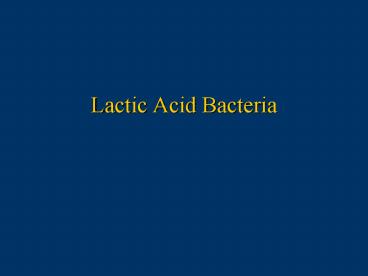Lactic Acid Bacteria - PowerPoint PPT Presentation
1 / 10
Title:
Lactic Acid Bacteria
Description:
Lactococci as components of starter cultures for fermented dairy products ... sake. Lb. brevis. Lb. buchneri. Lb. fermentum. Lb. reuteri. Lb. casei, by Broadbent ... – PowerPoint PPT presentation
Number of Views:2323
Avg rating:3.0/5.0
Title: Lactic Acid Bacteria
1
Lactic Acid Bacteria
2
Lactococcus lactis(L. lactis, Lc. Lactis)
L. lactis subsp. lactis
L. lactis subsp. cremoris
L. lactis subsp. diacetylactis
- - - -
- - - - - - - - - - -
- -
Growth at 10C Growth at 40C Growth at 45C Growth
in 4 NaCl Growth in 6.5 NaCl Growth at pH
9.2 Growth with methylene blue (0.1 milk) Growth
in the presence of bile (40) NH3 from
arginine CO2 from citrate Diacetyl and
acetoin Ferment of maltose Ferment ribose
3
Lactococci as components of starter cultures for
fermented dairy products
Type of product Composition of starter culture
1. Cheese types without eye formation (Cheddar,
Camembert, Tilsit) 2. Cottage cheese, quarg,
fermented milks, cheese types with few or
small eyes (e.g. Edam) 3. Cultured butter,
fermented milk, buttermilk, cheese types
with round eyes (e.g. Gouda) 4. Taette
(Scandinavian ropey milk)
Lc. lactis subsp. cremoris, 95-98, Lc. lactis
subsp lactis, 2-5 Lc. lactis subsp. cremoris,
95, Leuc. Mesenteroides subsp. cremoris, 5 or
Lc. lactis subsp. cremoris, 85-90, Lc. lactis
subsp. lactis 3 Leuc. mesenteroides subsp.
cremoris 5 Lc. lactis subsp. cremoris, 70-75,
Lc. lactis subsp. diacetylactis, 15-20 Leuc.
Mesenteroides subsp. cremoris, 2-5. Lc. lactis
subsp. cremoris (ropey strain)
From Teuber, in The Genera of Lactic Acid Bacteria
4
Lactobacillus spp.
- Group A
- Obligately homofermentative lactobacilli
- 6C to LA by glycolysis (EMP), possess
fructose-1,6-bisphosphate-aldolase (FDP), but
lack phosphoketolase (PK) - Group B
- Facultative heterofermentative
- EMP most, also possess FDP and PK
- Group C
- Obligately heterofermentative
Lactobacillus delbrueckii subsp. Bulgaricus, by
Broadbent
5
Lactobacillus spp.
- G
- Non-spore forming
- Rods or coccobacilli
- GC usually below 50
- Strictly fermentative, aero-tolerant or anaerobic
- Aciduric or acidophilic
- Complex nutritional requirements (carb, aa,
peptides, FA, salts, nucleic acid derivatives,
vit) - Homo or heterofermentative
6
- Arrangement of the Genus Lactobacillus
Lb. casei, by Broadbent
Group I obligately homofermentative
Group II facultatively heterofermentative
Group III obligately heterofermentative
Character
- - -
- Lb. acidophilus Lb. delbruckii Lb.
helveticus Lb. salivarius
-
Lb. casei Lb. curvatus Lb.
plantarum Lb. sake
-
Lb. brevis Lb. buchneri Lb. fermentum Lb.
reuteri
Pentose fermentation CO2 from glucose CO2 from
gluconate FDP aldolase present Phosphoketolase
present
7
Streptococcus thermophilus
- Also mentioned as S. salivarius subsp.
Thermophilus - Grow at 45C, and some even grow at 50C
- No growth in 0.1 methylene blue or at pH9.6
- Used in yogurt fermentation with Lb. delbrueckii
subsp. Bulgaricus - Also used in cheese making
S. thermophilus, by Broadbent
8
Pediococccus spp.
- Tetrads via cell division in two perpendicular
directions in a single plane - Acid tolerant, cannot synthesize porphyrins,
lactic acid as major metabolic end product - Strictly fermentative (homo) facultative
anaerobic - Need rich media (N, aa, nicotinic acid,
pantothenic acid, biotin, some require other Vit) - Catalase- (some Pseudo)
- GC 34-44
- Surface of plants and fruits
- Become predominant microflora in fermenting plant
materials (silage, sauerkraut, olives, etc.) - Diversified, some grow in beer, soy sause
- BeerAlso found in cured meat, raw sausages, and
marinated fish, and used in biotechnological
processing and preservation of foods
By Broadbent, USU, NCBI microbial genome
9
Leuconostoc spp.
- G, non-motile, shape vary with growth condition
- Complex nutrient requirement
- Facultative heterofermentative anaerobes,
- Optimal growth pH 6-7 except acidophilic species
- L. mesenteroides stops around pH 5.4-5.7
- L. mesenteroides subsp. mesenteroides associated
with sauerkraut (pickled cabbage) and dill pickle
fermentation - It also produces exopolysaccharides such as
dextran (polymer production) applications in
cosmetics, medical, and creation of sephadex gels
and beads
DOE JGI
10
Industry Applications of LAB
- Mesophilic and thermophilic starters used by
dairy industry - Mesophilic acid-forming lactococci and often
flavor producers - Thermophlic yogurt and cheese varieties with
high cooking temperatures - Starter functions
- Acid production
- Proteolytic activity
- Aroma formation
- Exopolysaccharide formation
- Production of inhibitory compounds































